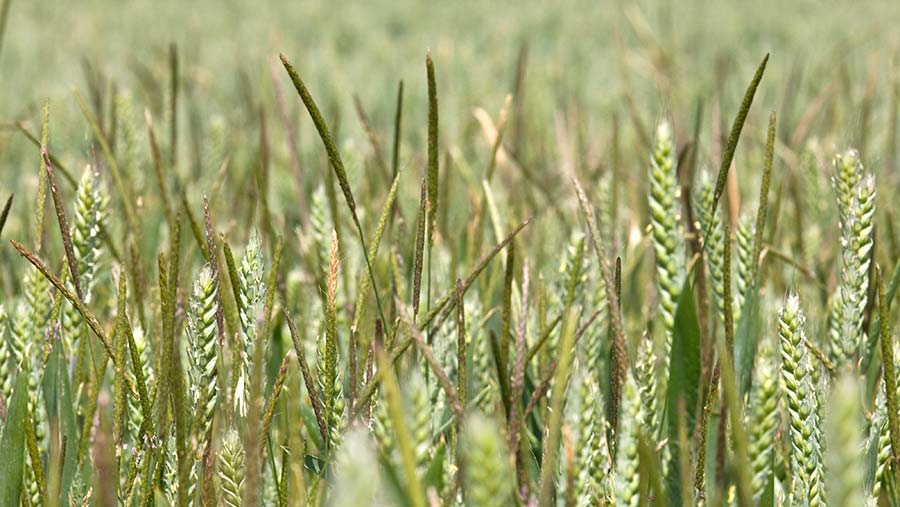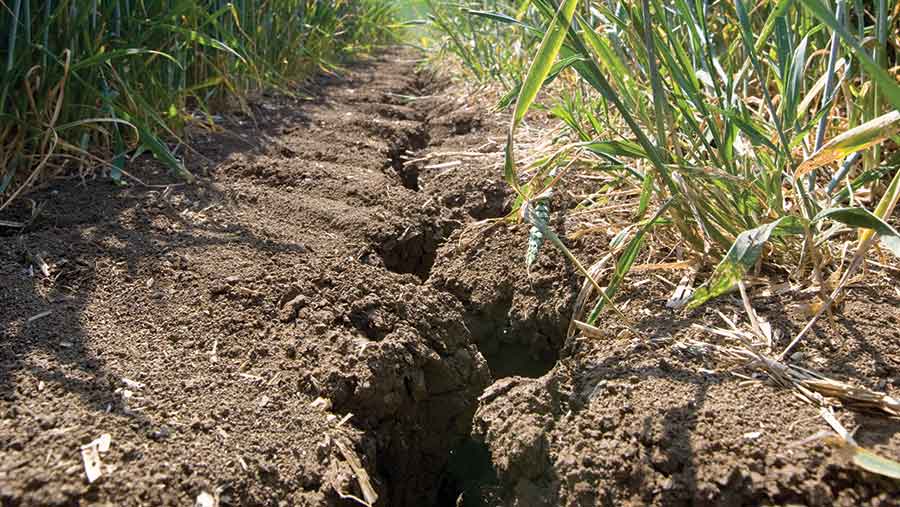Crop Watch: Growers count cost of drought and blackgrass
 © Tim Scrivener
© Tim Scrivener A lack of rainfall in recent weeks may have helped curb some disease threats such as potato blight in the North, but there are growing concerns on the impact of crop yields.
The vital grain-filling period is upon us and this week’s heatwave is likely to see some crops wither away with many already stressed due to lack of rainfall. Spring barley in the South, in particular, is being hit hard.
Another concern for our agronomists is the poor blackgrass control in some fields, which will prompt a rethink on strategy for next season.
South: Iain Richards
Agrii (Oxfordshire)

Iain Richards
Orange blossom midge proved just as troublesome as we feared it might. And along with brown rust in wheat and lack of moisture in spring barley, it remains a particular concern as we move towards what could be a promising harvest.
It’s a good 15 years since we’ve had to treat such a large area for blossom midge and, with only pyrethroids in our armoury, we’re now finding a worrying number of larvae in the ears of some crops.
See also: What the neonic seed treatment ban means for sugar beet
Acute midge problems meant some T3s went on slightly earlier than we’d have liked to avoid the need for separate sprays within barely a week. Fine for fusarium protection, this has left us with the challenge of keeping the many varieties at high risk of brown rust clean at a time we’re forecast to get the hot, dry weather the disease loves.
Thankfully, our T2-T3 interval was well under three weeks in most cases. So continued activity from Solatenol (benzovindiflupyr) we used widely as our flag leaf SDHI on susceptible varieties should bolster our T3 azole combinations.
We’re not planning to do so, but if brown rust comes in to any significant extent we won’t hesitate to go back in with a T4. Especially for the later wheats that need to stay green for another four weeks.
We may have been cursing it back in April, but having more than enough moisture in the ground going into the summer has been a godsend. No rain worth mentioning for three weeks is leaving winter crops on the gravels looking stressed. However, it hasn’t done most of our acreage much harm yet.
Spring barley woes
The same cannot, unfortunately, be said for our spring barleys. Where they went in well and got enough early nitrogen they’re carrying a decent number of tillers.
While March drillings are averaging nearly 30 grains/ear, those that didn’t go in until mid-April have less than 20 grains/ear. And they’re all badly in need of a drink.
It definitely won’t be a record spring barley year. Having said that, feed prices are firm and malting premiums are holding-up. So decent spring barleys will repay the effort put into creating them.
We’ve been very pleased with the grassweed control we’ve achieved this season but incredibly disappointed with the few cases in which a spring clean-up has been needed. This has underlined we no longer have any reliable fallback once winter crops are established – even where blackgrass levels are moderate.
East: Sean Sparling
AICC/SAS Agronomy (Lincolnshire)
 Winter wheat and barley are now on the final push, though wet weather throughout flowering may yet cause us problems with fusarium ear blight, but ear and foliar disease levels still appear remarkably low. Crops are still standing too.
Winter wheat and barley are now on the final push, though wet weather throughout flowering may yet cause us problems with fusarium ear blight, but ear and foliar disease levels still appear remarkably low. Crops are still standing too.
Blackgrass is an annoyance in a few too many fields and weed-wipers, mowers, sprayers and roguing gangs are a common sight on the wolds, heath and fen alike.
It may be a case of going back to basics this autumn with the emphasis on attention to detail – glyphosate for initial flushes, delayed drillings, quality seed-beds, rotations crucial, nerves of steel and vital targeted use of robust residuals – a combination of all these is crucial.
Spring barley and spring wheat are finished as far as fungicides go. Much higher levels of rhynchosporium, net blotch, abiotic spotting and ramularia are being seen, but no surprise thanks to the stresses of a late drilling season, snow, heatwaves, torrential downpours, hurricanes and frosts. The frosts caused high levels of blind grain sites in some areas.
Spring wheat
Spring wheats look good, but may yet show the wisdom of “cuckoo wheat” folklore. Sugar beet is now at full cover in many fields with no disease, bugs, moths or leaf miners to report.
Peas and beans are flowering and podding well, however, downy mildew and botrytis are an issue due to the blighty conditions. Thankfully, the bug and beetle levels remain manageable – for now at least.
With Hutton periods occurring almost every day, potato blight programmes are necessarily robust and routine – seven day plans are in full force.
This season continues to frustrate. Two weeks ago, 83mm of rain fell in 95 minutes 12 miles away and I took just 0.2mm the same day and only 7mm this month.
Growers are desperate for rain and are irrigating beet and cereals in fields with cracks 3in across, while over-wetted neighbours gaze guiltily from just over their lush hedges.
North: Andy Goulding
CAS/Hutchinsons (Cheshire)

Andy Goulding
With only 28mm of rain in May and 6mm in June (at the time of writing) there are many combinable crops now starting to wither away. With a heatwave forecast there are likely to be many more casualties, especially those crops with shallower roots.
Many spring cereals have been under such stress they have skipped tillering with producing offspring as the only goal.
Soil texture differences within field are now obvious to spot with the sandier patches going off to a line.
We now lie in hope the forecast will change and crops will have some rain to help fill what grain sites are there.
This year seems one of those extremely rare occasions where the East’s weather has swapped with the West’s.
With no rain to wash granular fertiliser in, there have been many applications of amine nitrogen as a foliar spray.
This is now finding a firm place as a genuine part of a nutrition programme with its far superior, simple and safe uptake and excellent tank mix-ability.

© Tim Scrivener
Potato pressure
Blight pressure is low and as such there is no requirement for curative products or tight intervals at present. The problem we have faced, however, has been weed control. Even timed to the most favourable of application windows we have still had problems.
Cloddy seed-beds from a wet spring and bone dry ridges has led to the word Titus (rimsulfuron) cropping up all across town.
This is the last thing we want in current conditions in late-planted crops, but where not applied, I have heard of some particularly weedy scenarios competing hard with the crop.
Maize crops are also a mixed bag. Some had just about finished the flush of weeds and were about to close over the rows, which made herbicide timing difficult. In other crops that are struggling, you can still walk between the rows without too much resistance from brushing your legs on the leaves.
There have been many purpled and yellowed crops as they have struggled to extract nutrition from the soil so there has been plenty of foliar intervention including nutrition and biostimulants to help them on their delayed flight from the ground.

